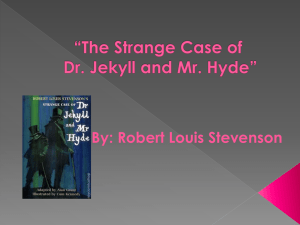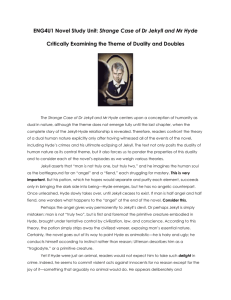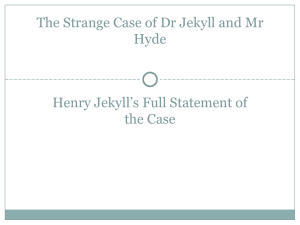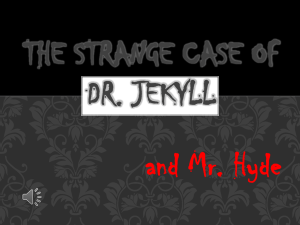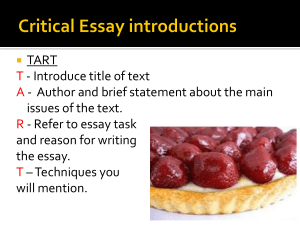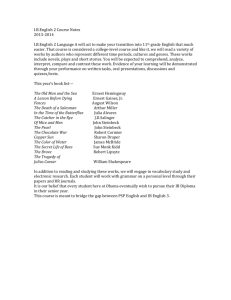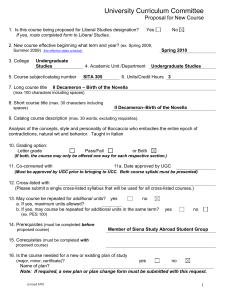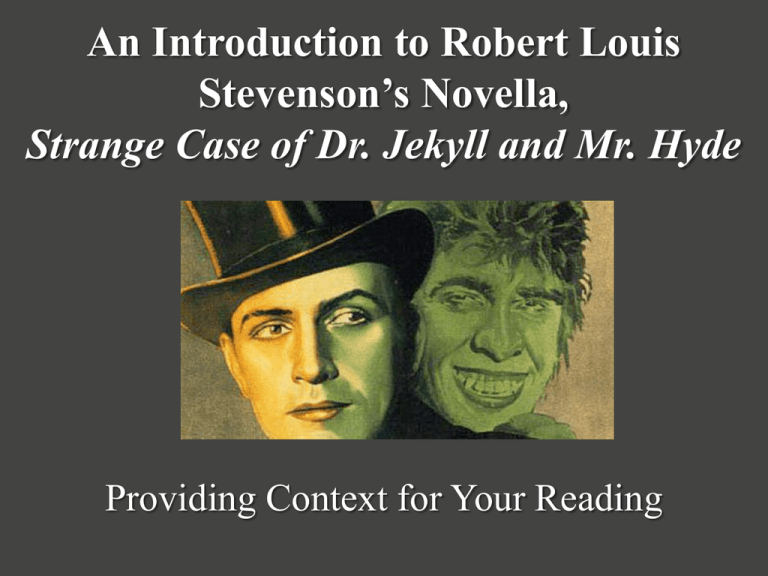
An Introduction to Robert Louis
Stevenson’s Novella,
Strange Case of Dr. Jekyll and Mr. Hyde
Providing Context for Your Reading
After Robert Louis Stevenson’s death in
1894, his friend and fellow author, Henry
James, wondered “whether Louis’s work
itself doesn’t pay somewhat for the so
complete exhibition of the man and the
life….The achieved legend and history that
has him for subject, has made, so to speak,
light of their subjects, of their claim to
represent him.”
About the Author
• Robert Louis Stevenson (1850-1894) became an international
literary star as a result of the popular press of the late nineteenth
century.
• The Daily Mail was Britain's first daily newspaper aimed at the
newly literate "lower-middle class market resulting from mass
education combining a low retail price with plenty of
competitions, prizes and promotional gimmicks”.
• He was a lifelong invalid (with a lung disease that was never
specifically diagnosed), yet he was able to travel the world to the
benefit of his stories and their vivid settings.
About the Author
• Robert Louis Stevenson wrote boys’ adventures,
pirate romances, horror stories, children’s poetry,
and plays.
• He was an atheist (obsessed with religious
questions), a workaholic, he had anti-establishment
views of politics, and he lived as a Bohemian artist
• One of his most famous published works is the
adventure novel, Treasure Island (1883), which
began a “Romance Revival” that refocused the
subject of literature on the study of character.
Characteristics of Romantic Literature
• Romanticism saw a shift from faith in reason to faith in the
senses, feelings and imagination.
• A shift from interest in urban society to an interest in the
rural and natural.
• A shift from concern with the scientific and mundane to
interest in the mysterious and infinite.
• Mainly romantics cared about the individual, intuition, and
imagination.
Early Reviews of Strange Case of
Dr. Jekyll and Mr. Hyde (1886)
• Due to the fact that Stevenson’s writing veered constantly
between high literary ambition and writing in commercial
forms for money, many of his critics were confused as to
where to place this novella.
• Some critics saw as nothing more than a “shilling shocker”
and commented “familiarity with which has bred in the minds
of most readers a certain measure of contempt”.
High and Low Literature Collide
and Equal Success for Stevenson
• The novella was dreamt up, written, rewritten (after the first
version was burned) and published in less than ten weeks
(rushed for the Christmas market), and although its place in the
literary canon was debated at first, it soon became undeniable
that Secret Case of Dr. Jekyll and Mr. Hyde quickly became a
commercial success.
• 40,000 copies of the novella were sold in England in six months,
and tens of thousands of copies were pirated in America.
• After Stevenson’s death, the original text was crudely stripped of
its nuances and perplexities, so as readers, we have to work hard
to read the original version in a proper set of contexts.
Important Background on the Novella
• The premise of the novella came to Stevenson in a
dream – “All I dreamed about Dr. Jekyll was that
one man was being pressed into a cabinet, when he
swallowed a drug and changed into another human
being. I awoke and said at once that I had found the
missing link for which I had been looking so long,
and before I went to sleep almost every detail of the
story, as it stands, was clear to me.”
• The first version of the novella was burned, which it
its very construction, begins the theme of strange
doubling, a shadow twin resigned to the fire.
Important Background on the Novella
• The novella is a product of an uneasy collaboration
between the waking and the dreaming self.
• The effect is that there is something very dream-like
about reading the story. Descriptions have a
hallucinatory quality.
• The story begins as a detective fiction, but like a
dream, it gets distracted, and evolves into something
more dark and unnerving (pay attention to the
interesting structure of this novella as a point that
deserves further analysis and discussion – the
structure of the secret and how it is revealed).
Narration in the Novella
• There are 3 main narrators in the text: Mr. Utterson
(the nervous lawyer), Hastie Lanyon (the
materialistic medic), and Dr. Jekyll’s own account of
events.
• There are other narrators who also interject in the
narrative: Enfield’s story of the door (seemingly
inconsequential), and the murder of Sir Danvers
Carew is filtered through the newspaper reports of a
maid’s eye witness account.
• The identity of the narrator is unclear in the novel’s
final sentence. Pay attention to this!
Elements of Gothic Literature in the Text
• Stevenson embeds the supernatural in the everyday,
a strategy often used in Victorian Gothic literature.
• Elements of Gothic Literature:
- Ancient Prophesy or Omens
- High Emotion
- Supernatural Events
- Characters in Distress
- Setting as a Metaphor for Horror
The Role of The Double in the Text
• Doubles are everywhere in the text: Jekyll and Hyde
are discussed by Utterson and Enfield, Utterson and
Lanyon, Poole and Utterson…Consider the many
characters who are doubles of one another in this
story.
• The concept of the alter ego, the
second self, and the supernatural
evil twin are examined.
• Explores the mysteries of the
modern self (strangers to ourselves)
A Historical Context: Crime, Sex, Class
and Urbanism in 1880’s London
• Enfield’s opening story (discussing blackmail, abuse,
lynching) in the text triggers a whole set of anxieties
that were occupying London opinion in the mid-1880’s.
• Blackmailers were becoming “the most infamous of
criminals”
• Child prostitution and sexual violence was recently
exposed as a severe problem that was only increasing in
its prevalence at the time.
• Consider that Jack the Ripper (infamous serial killer)
was active around the streets of London two years after
Jekyll and Hyde was published (1888).
• Violent class war was a concern of many at the time.
Enjoy your reading of this wonderful
novella. It is rich with descriptive language,
potent imagery, and shocking revelations
throughout.
Proceed with curiosity…

